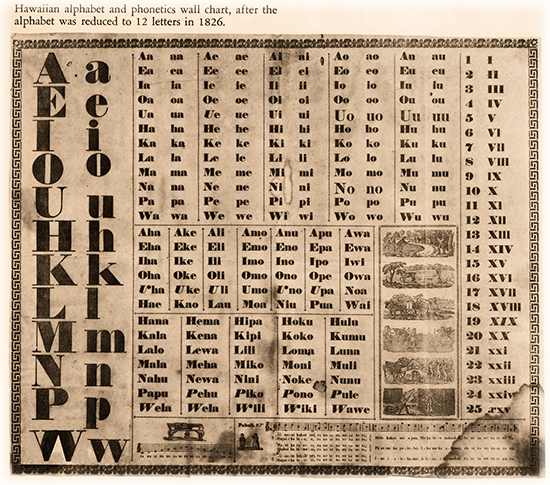
Historical Event Timeline
The Written Hawaiian Language

The Written Hawaiian Language
The Written Hawaiian Language
The arrival of the first Protestant missionaries to travel to Hawai‘i (from New England) marked a seminal step in the history of the Hawaiian language. Enthusiastic about conveying their message of Christianity, these missionaries introduced an alphabet and an orthography that would be used in producing the printed word in the Hawaiian language (for the first time). Books were printed and published (most notably The Holy Bible – Ka Palapala Hemolele in Hawaiian), and people learned how to read and write in their native language.
The arrival of the first Protestant missionaries to travel to Hawai‘i (from New England) marked a seminal step in the history of the Hawaiian language. Enthusiastic about conveying their message of Christianity, these missionaries introduced an alphabet and an orthography that would be used in producing the printed word in the Hawaiian language (for the first time). Books were printed and published (most notably The Holy Bible – Ka Palapala Hemolele in Hawaiian), and people learned how to read and write in their native language.
I. The written Hawaiian language
A. The special influences that allowed this written language to evolve. 1. Foreigners – haole from the post-discovery period (after 1778) and their influence.
2. The voyages and education of Henry ‘Opukahai‘a
a. His remarkable presence in his adopted New England society.
b. The story of his life told through his memoirs published one year after his untimely death in 1817.
c. The spiritual and intellectual fervor that these memoirs produced in Congregational parishes throughout New England.
d. The pledge and invitation that his memoirs conveyed.
3. The organizing, vetting and outfitting of the first company of Protestant missionaries selected to travel to the Hawaiian Islands (in 1819 referred to as the Sandwich Islands).
a. The hardships and complications of the journey of the First Company traveling 18,000 miles around Cape Horn (at the southern most tip of South America)
b. Their arrival and initial contact with the Hawaiian people (particularly with the ali‘i – royalty).
A. The special influences that allowed this written language to evolve. 1. Foreigners – haole from the post-discovery period (after 1778) and their influence.
2. The voyages and education of Henry ‘Opukahai‘a
a. His remarkable presence in his adopted New England society.
b. The story of his life told through his memoirs published one year after his untimely death in 1817.
c. The spiritual and intellectual fervor that these memoirs produced in Congregational parishes throughout New England.
d. The pledge and invitation that his memoirs conveyed.
3. The organizing, vetting and outfitting of the first company of Protestant missionaries selected to travel to the Hawaiian Islands (in 1819 referred to as the Sandwich Islands).
a. The hardships and complications of the journey of the First Company traveling 18,000 miles around Cape Horn (at the southern most tip of South America)
b. Their arrival and initial contact with the Hawaiian people (particularly with the ali‘i – royalty).
4. The introduction and influence of an alphabet (and its eventual
orthography) leading to the development of a written Hawaiian
language.
a. The role of the printing press and creation of the first printed works in the Hawaiian language.
b. The dissemination of literature and intellectual concepts taken from classical literary works.
5. The unique role of the select corps of missionaries entrusted with the establishment of schools for both royal students and commoners.
a. The Cooke’s (Amos Starr and Juliette Montague) and their teaching at the Chief’s Children’s School from 1839-1850.
b. The curriculum that Cooke’s introduced based on their own formal educational experiences and values.
c. The legacy of respect for civic education imparted by the Cooke’s and their colleagues.
d. Their use of teaching aids such as Samuel Griswold Goodrich’s (publishing under the pseudonym of Peter Parley) book Young America: A Book of Government and Law.
a. The role of the printing press and creation of the first printed works in the Hawaiian language.
b. The dissemination of literature and intellectual concepts taken from classical literary works.
5. The unique role of the select corps of missionaries entrusted with the establishment of schools for both royal students and commoners.
a. The Cooke’s (Amos Starr and Juliette Montague) and their teaching at the Chief’s Children’s School from 1839-1850.
b. The curriculum that Cooke’s introduced based on their own formal educational experiences and values.
c. The legacy of respect for civic education imparted by the Cooke’s and their colleagues.
d. Their use of teaching aids such as Samuel Griswold Goodrich’s (publishing under the pseudonym of Peter Parley) book Young America: A Book of Government and Law.
Selected Bibliography
Benedetto, Robert. The Hawaii Journals of the New England Missionaries 1813-1894.
Honolulu: Hawaii Mission Children’s Society, 1982.
Bingham, Hiram. A Residence of Twenty-One Years in the Sandwich Islands. Tokyo: Charles E. Tuttle, 1981.
Day, A. Grove and Albertine Loomis. Ka Pa‘i Palapala – Early Printing in Hawaii. Honolulu: Hawaiian Mission Children’s Society, 1997.
Goodrich, Samuel G. The Young American: or Book of Government and Law. New York: Mark H. Newman and Company, 1847.
Loomis, Albertine. Grapes of Canaan: Hawaii 1820. New York: Dodd, Mead, 1951.
Richards, Mary Atherton. Amos Starr Cooke and Juliette Montague Cooke. Honolulu: Daughters of Hawaii, 1987.
Peter Salter Research Historian RIHi.USA
Benedetto, Robert. The Hawaii Journals of the New England Missionaries 1813-1894.
Honolulu: Hawaii Mission Children’s Society, 1982.
Bingham, Hiram. A Residence of Twenty-One Years in the Sandwich Islands. Tokyo: Charles E. Tuttle, 1981.
Day, A. Grove and Albertine Loomis. Ka Pa‘i Palapala – Early Printing in Hawaii. Honolulu: Hawaiian Mission Children’s Society, 1997.
Goodrich, Samuel G. The Young American: or Book of Government and Law. New York: Mark H. Newman and Company, 1847.
Loomis, Albertine. Grapes of Canaan: Hawaii 1820. New York: Dodd, Mead, 1951.
Richards, Mary Atherton. Amos Starr Cooke and Juliette Montague Cooke. Honolulu: Daughters of Hawaii, 1987.
Peter Salter Research Historian RIHi.USA
